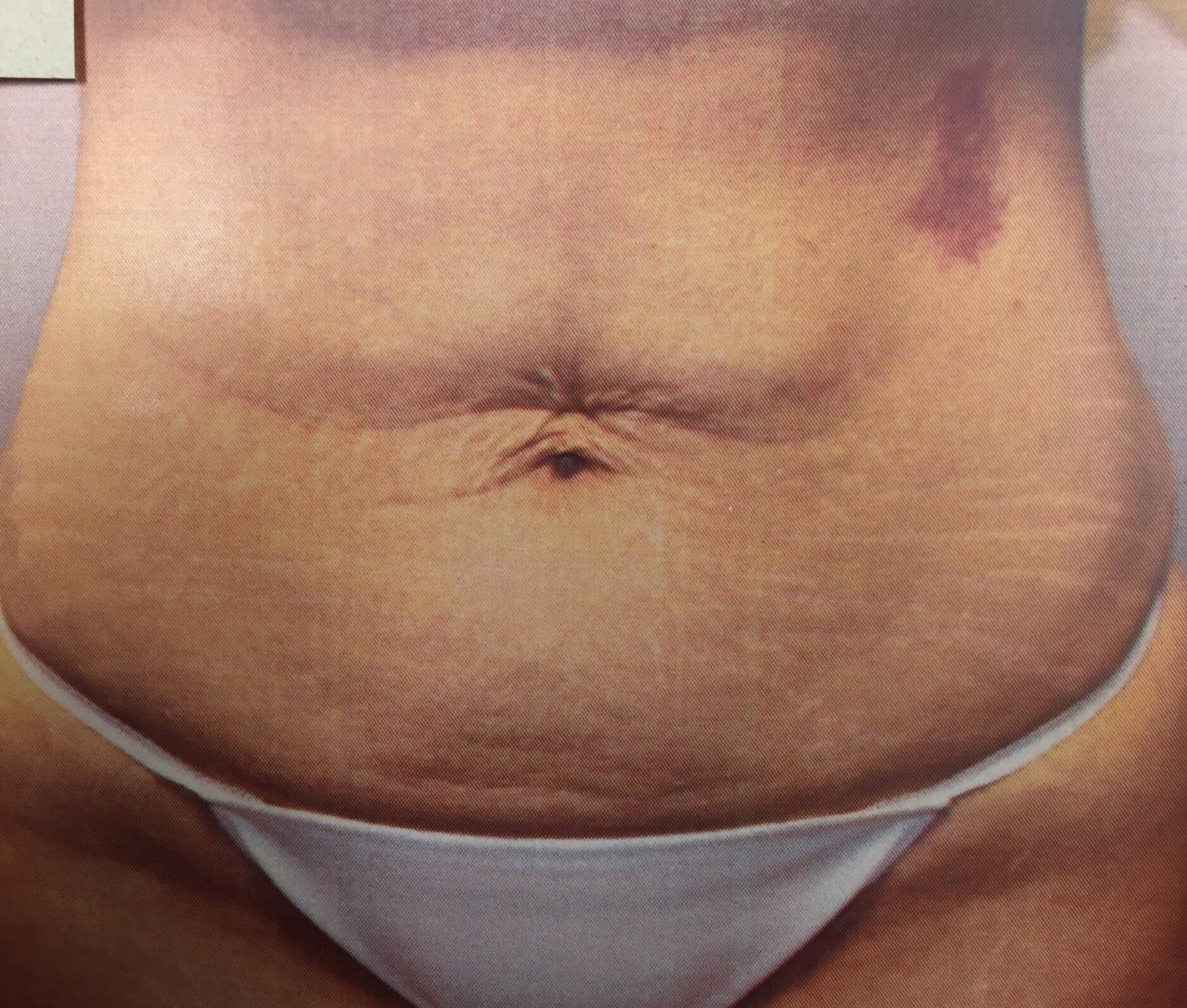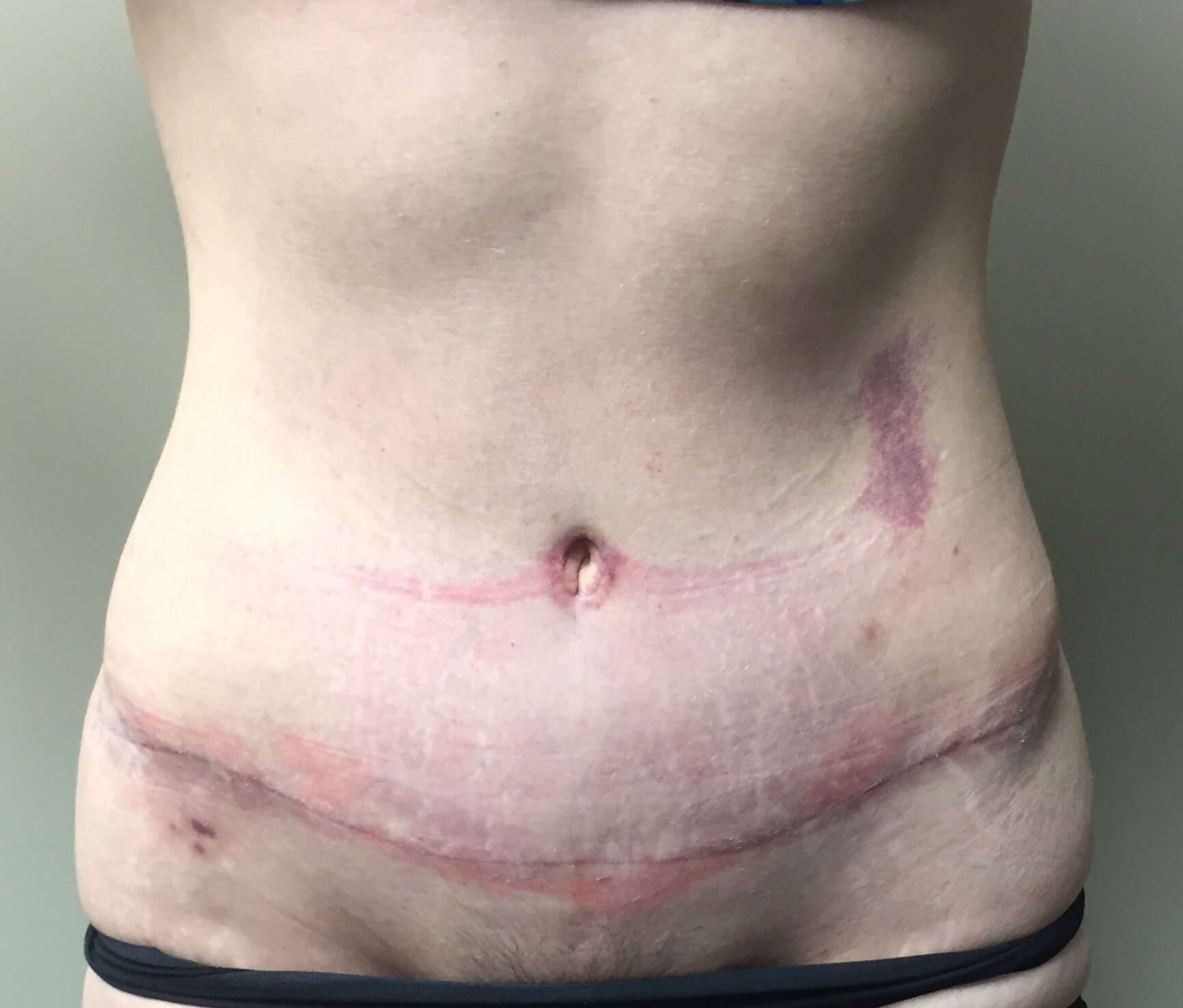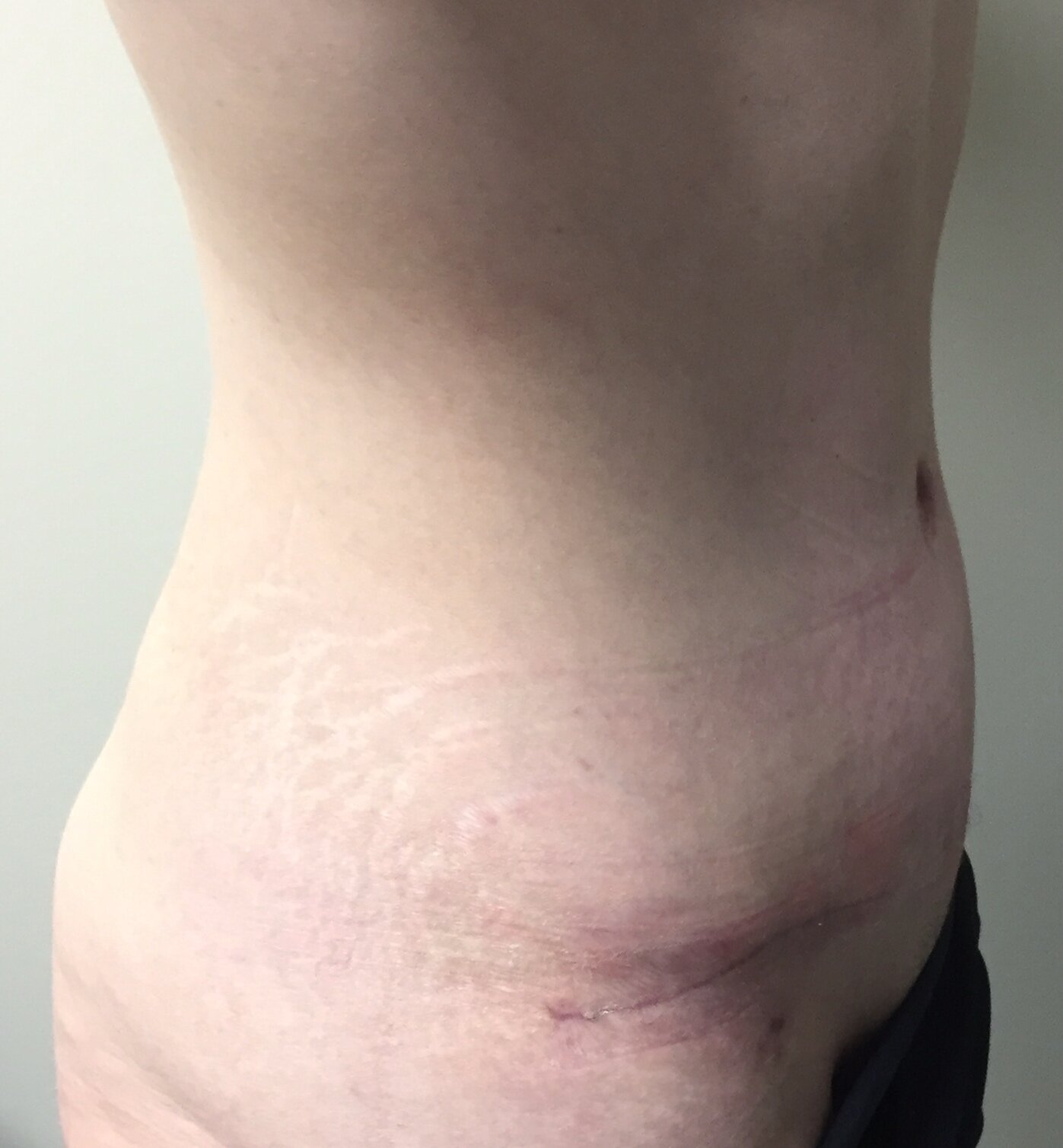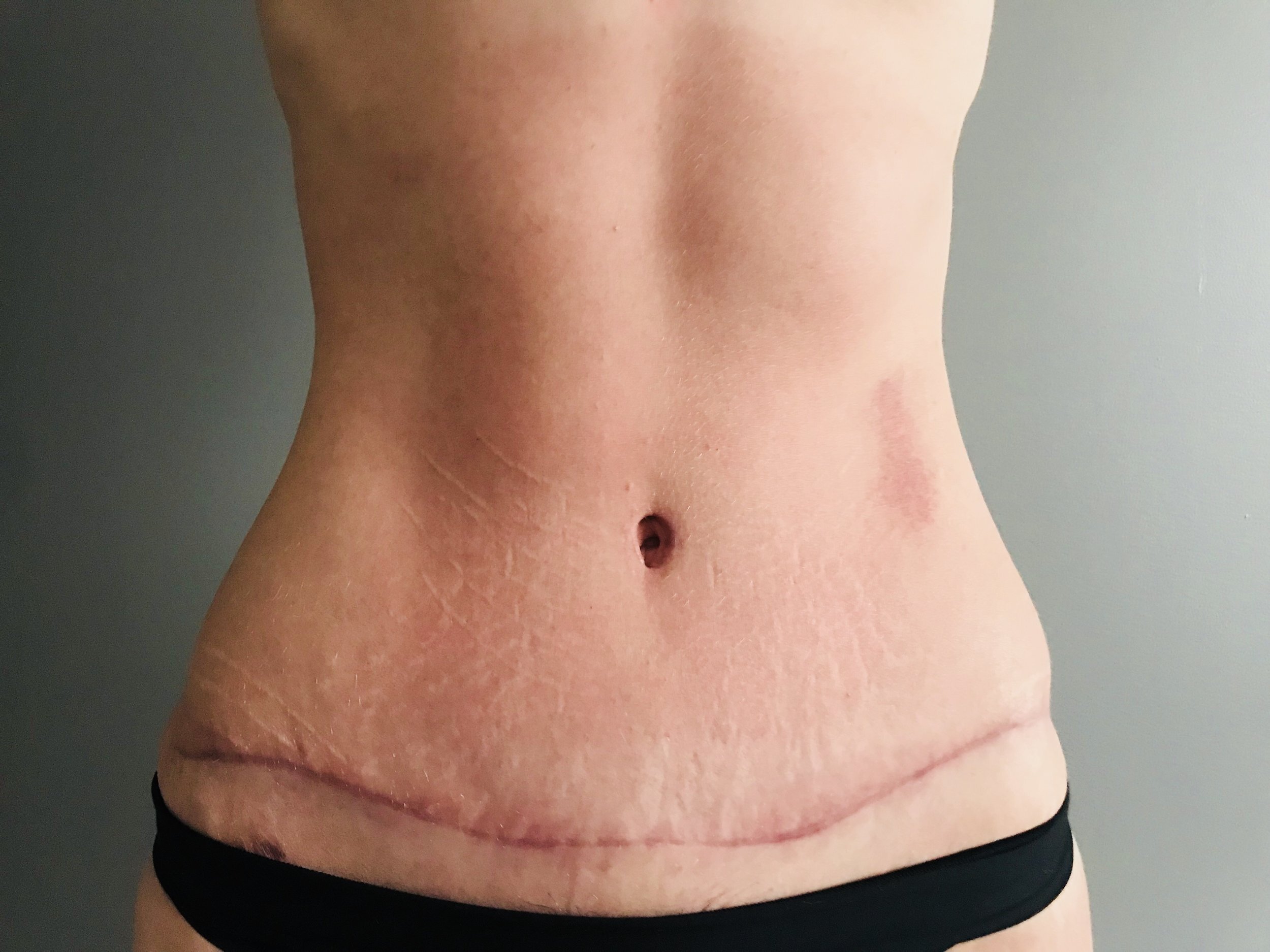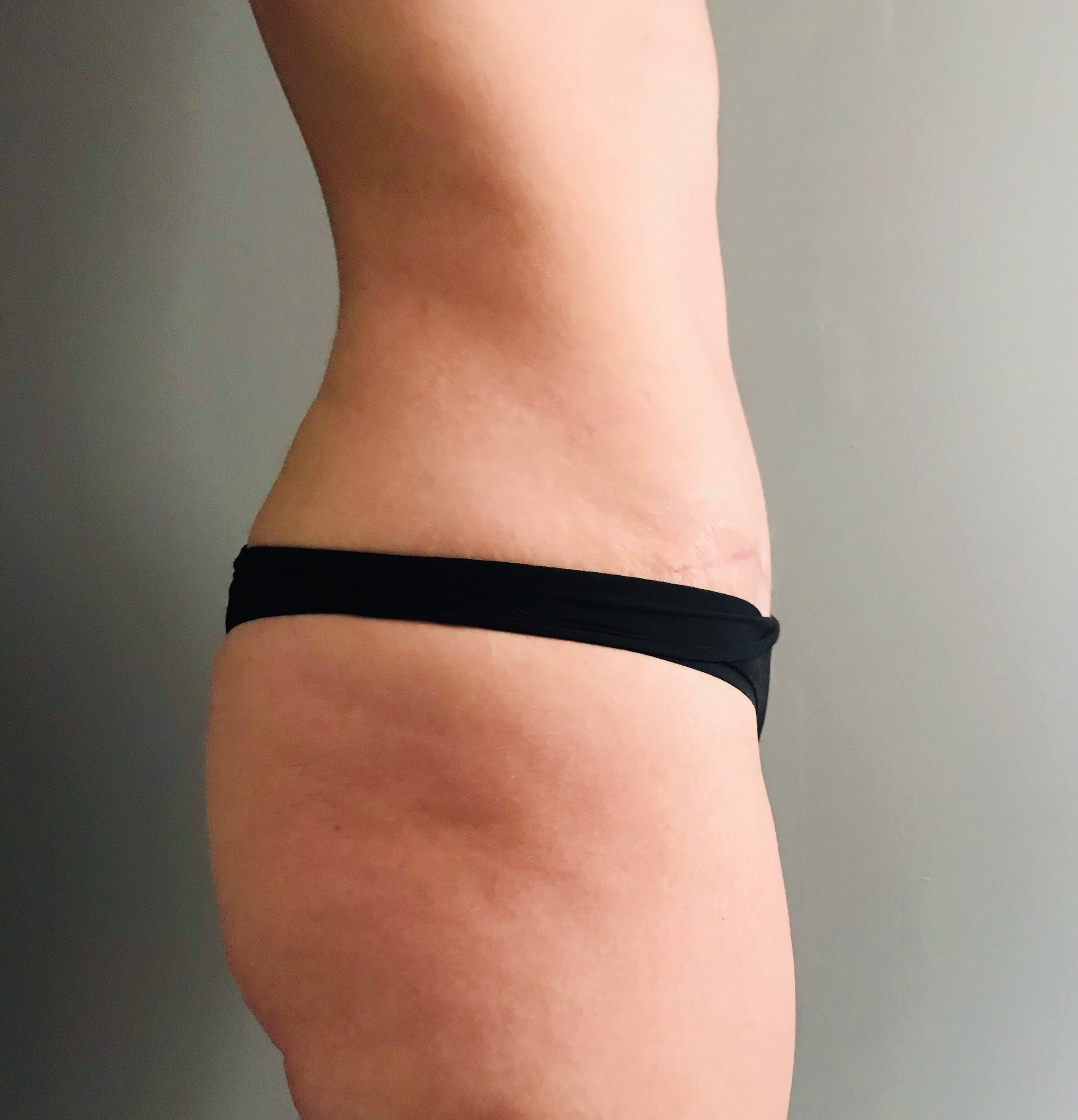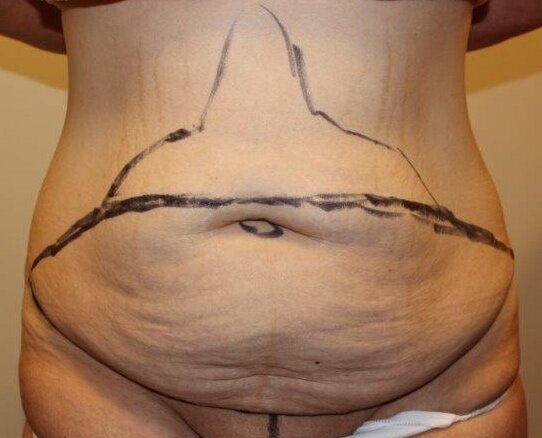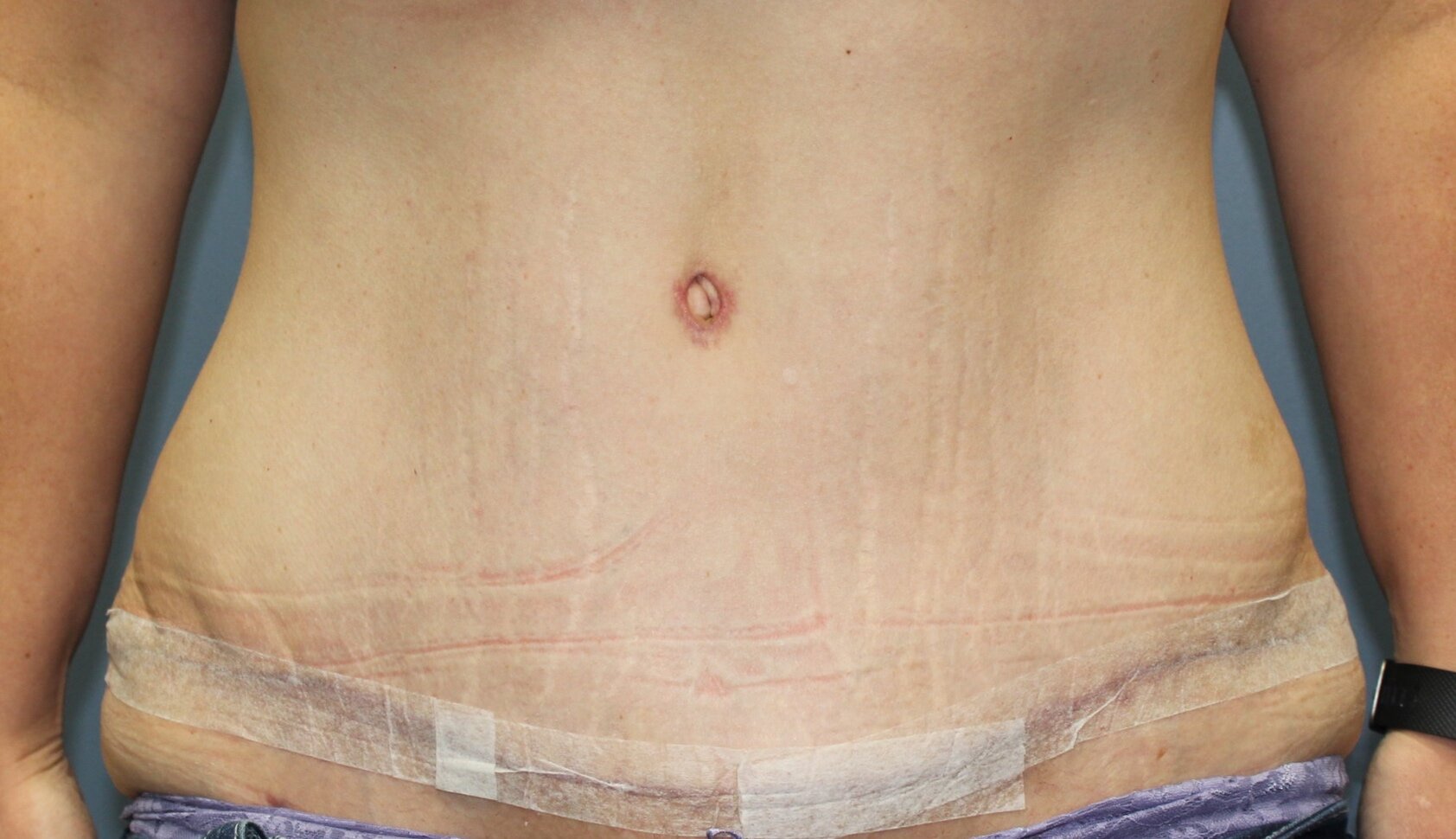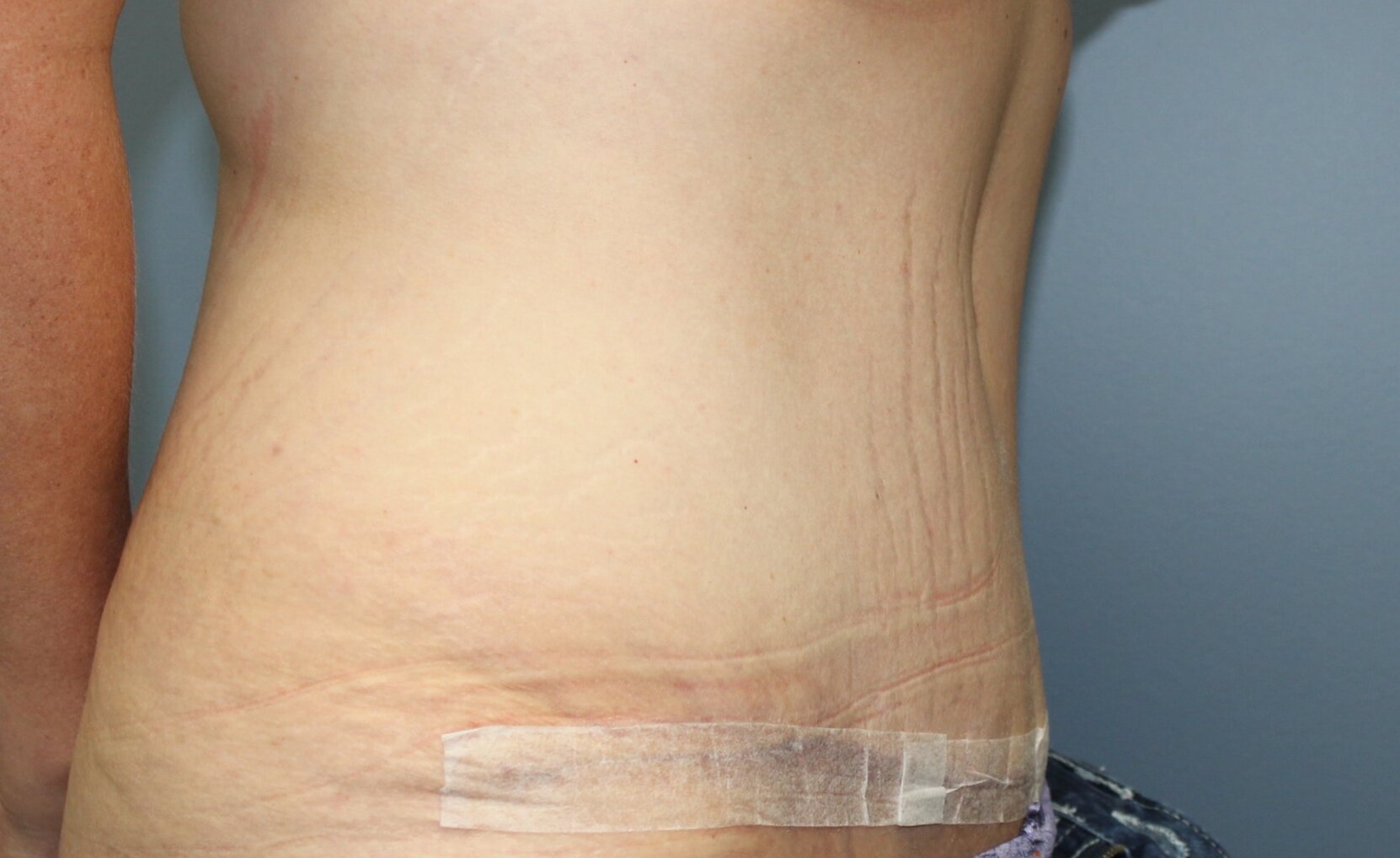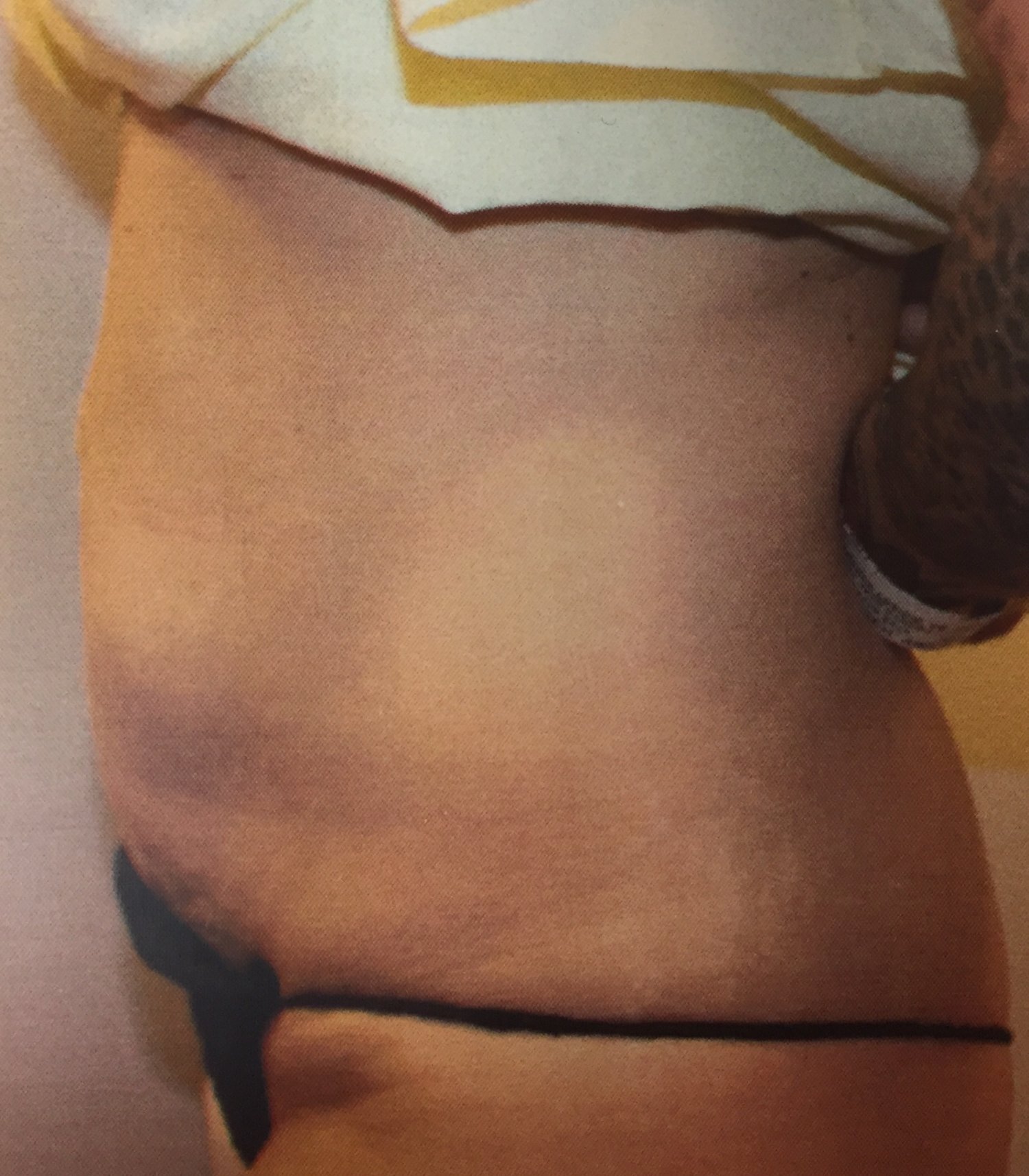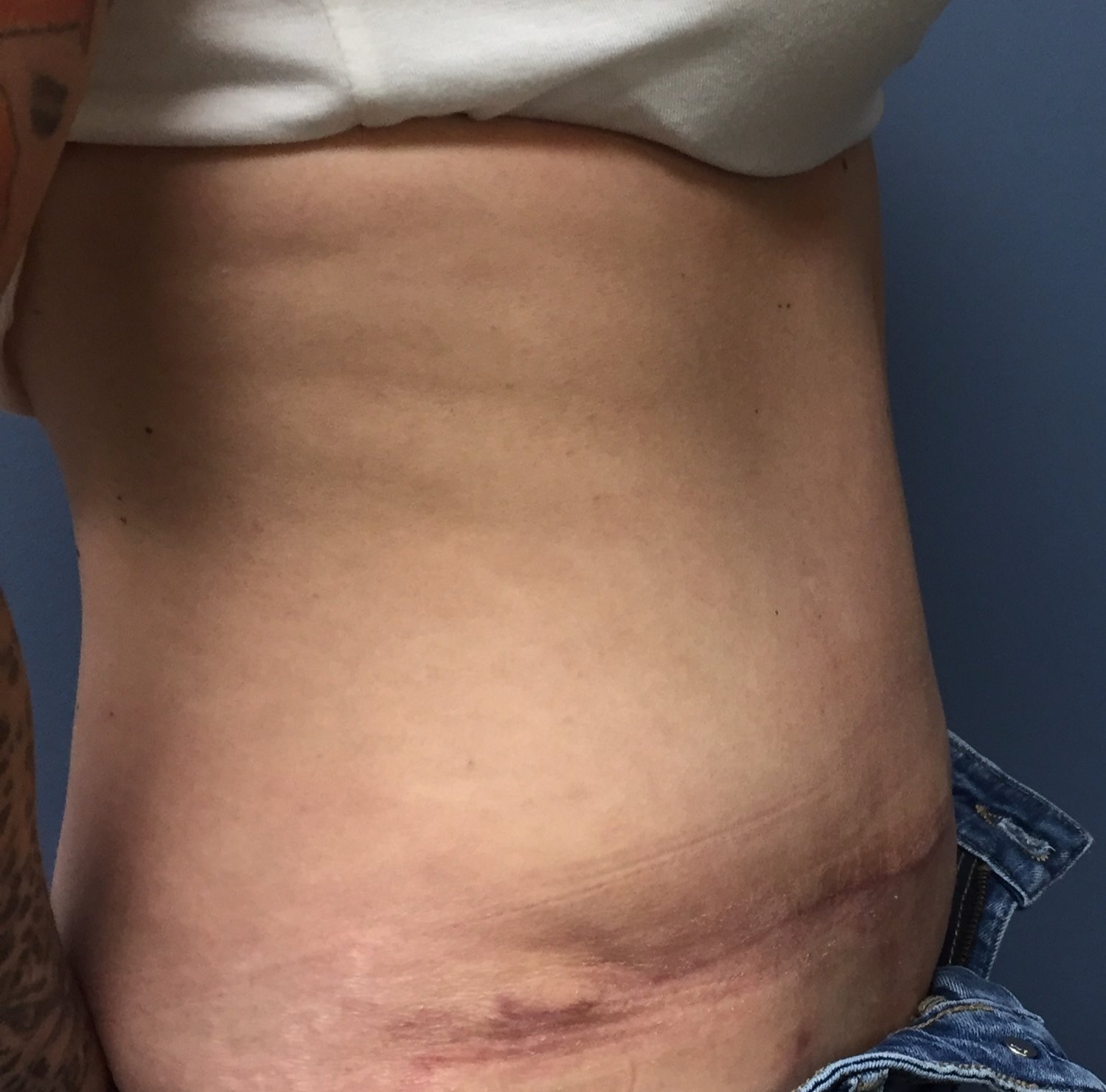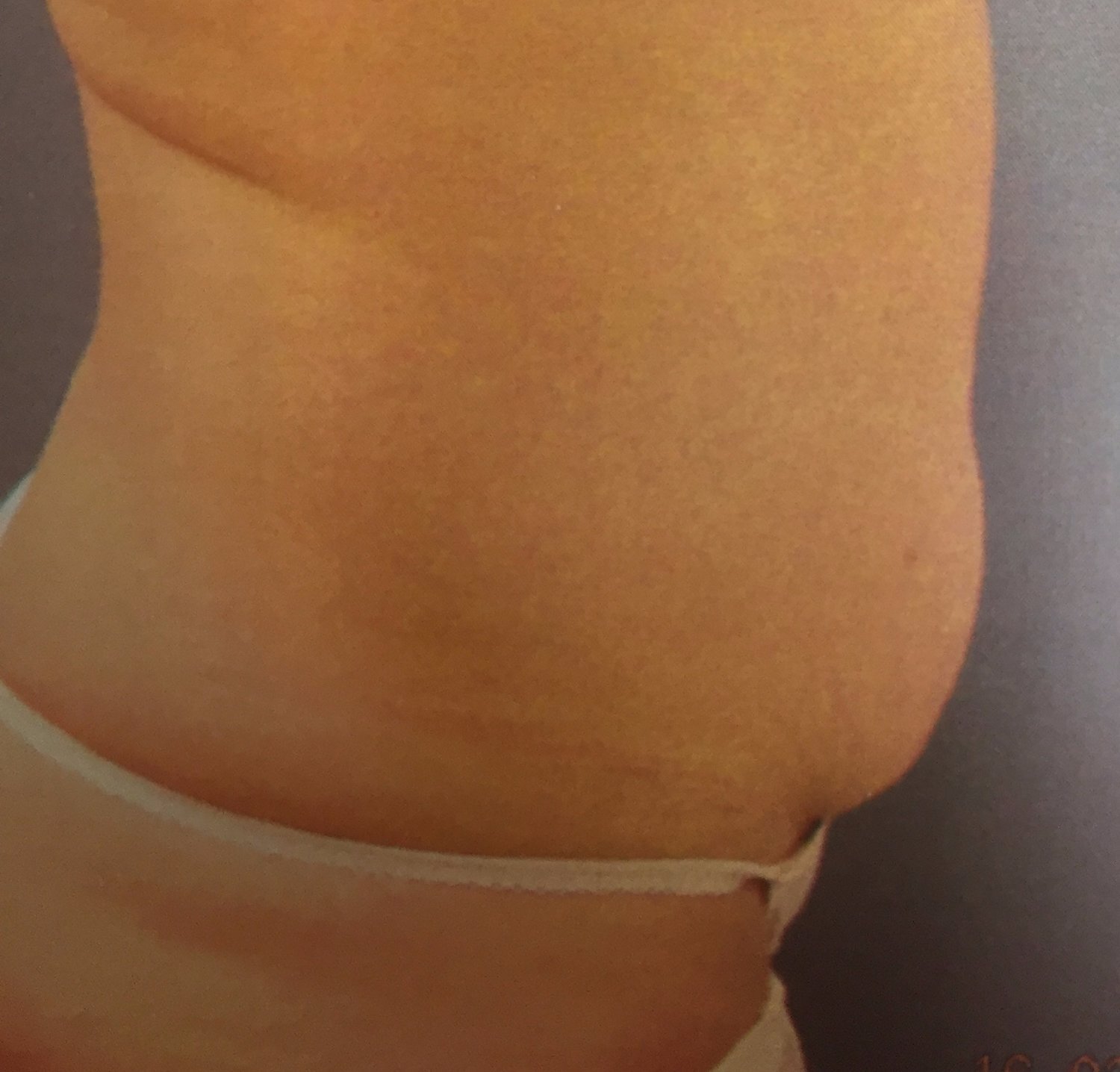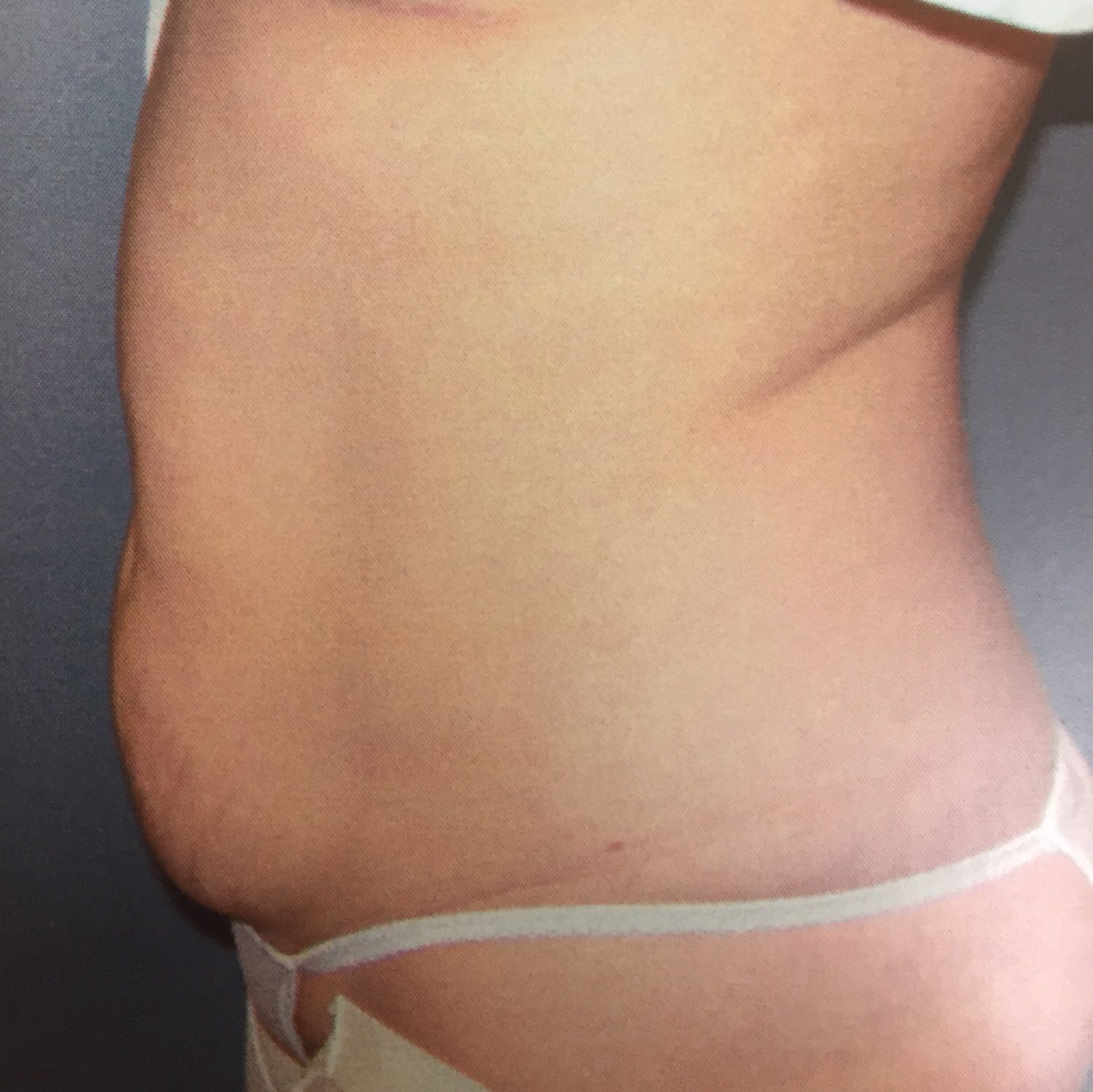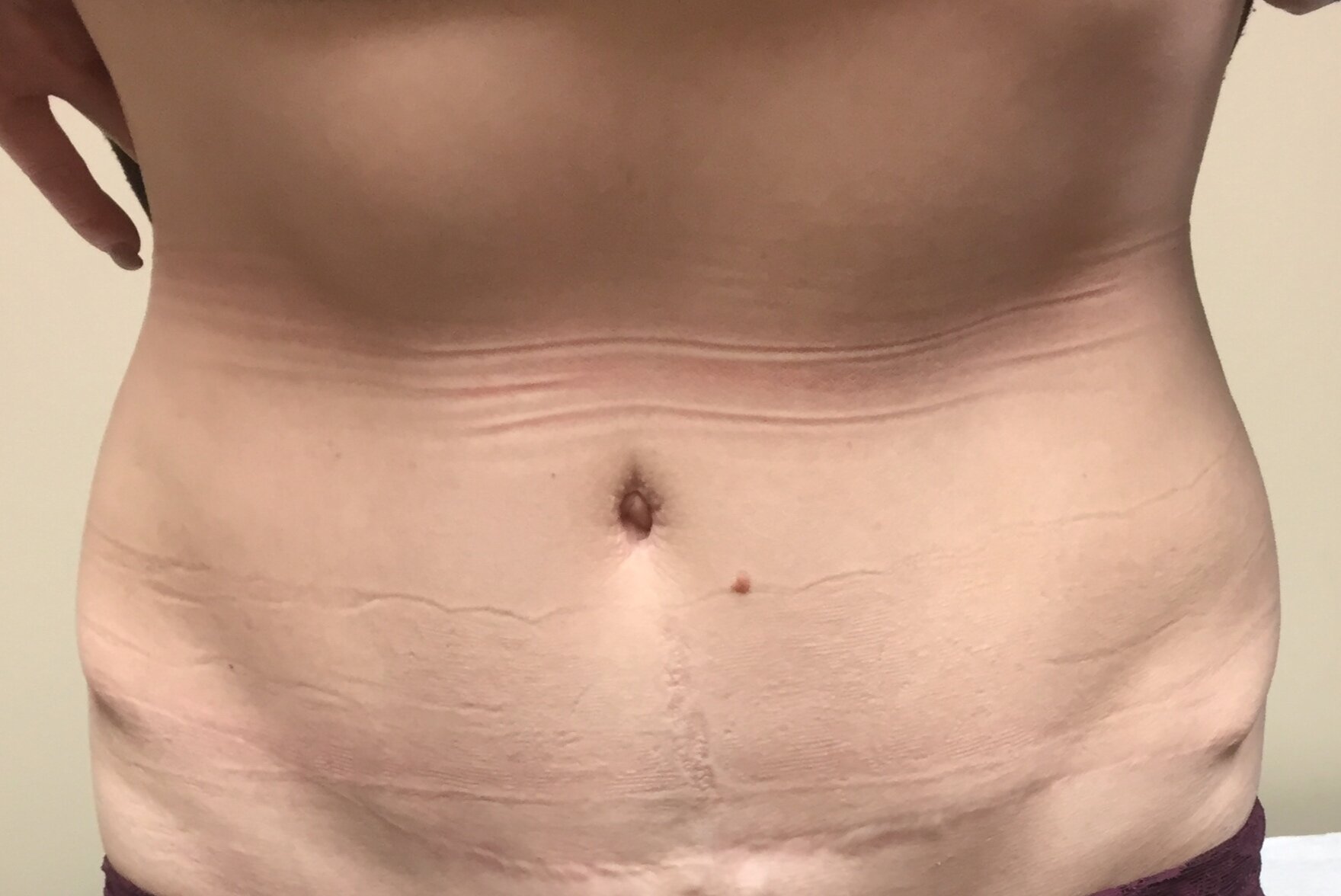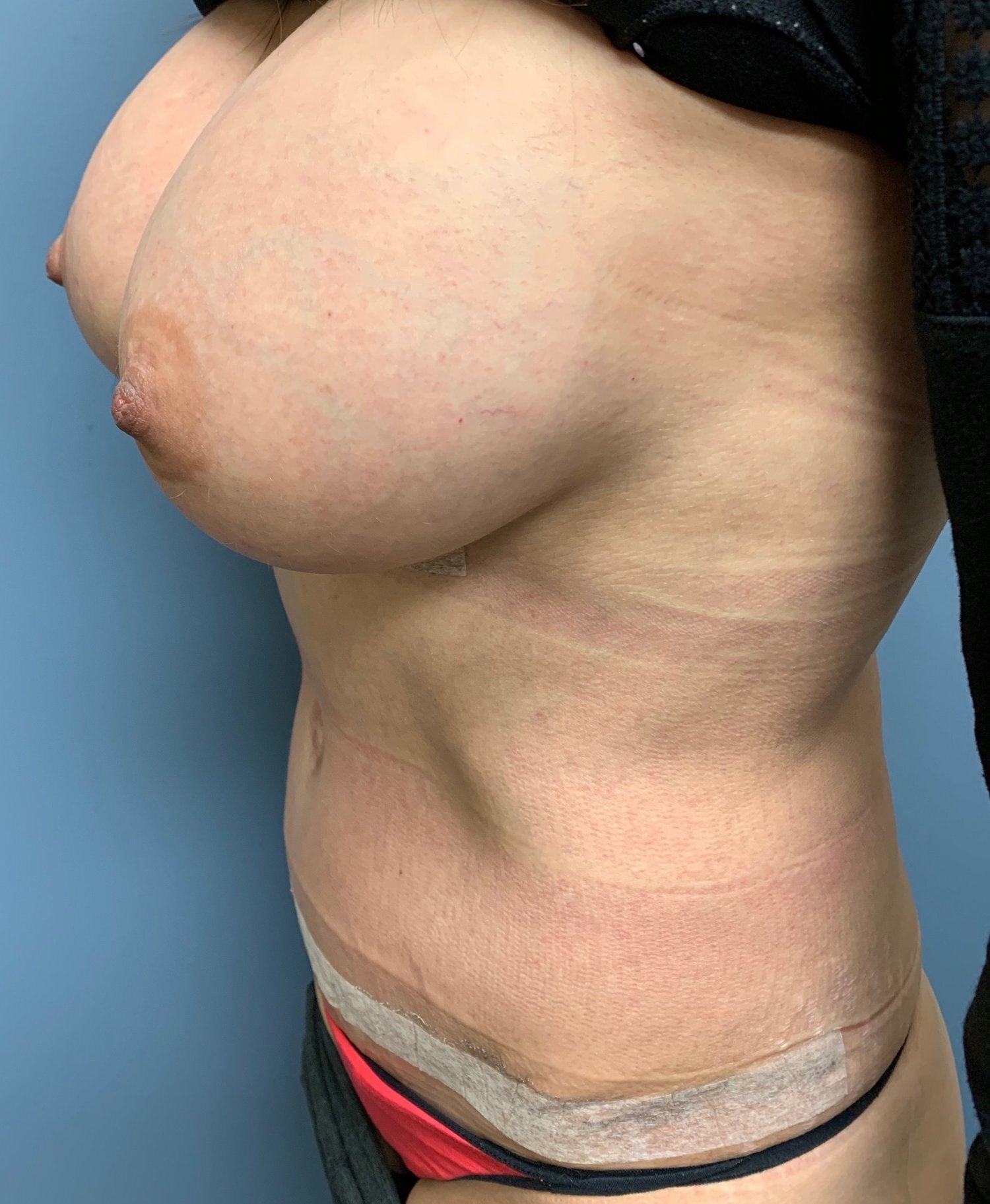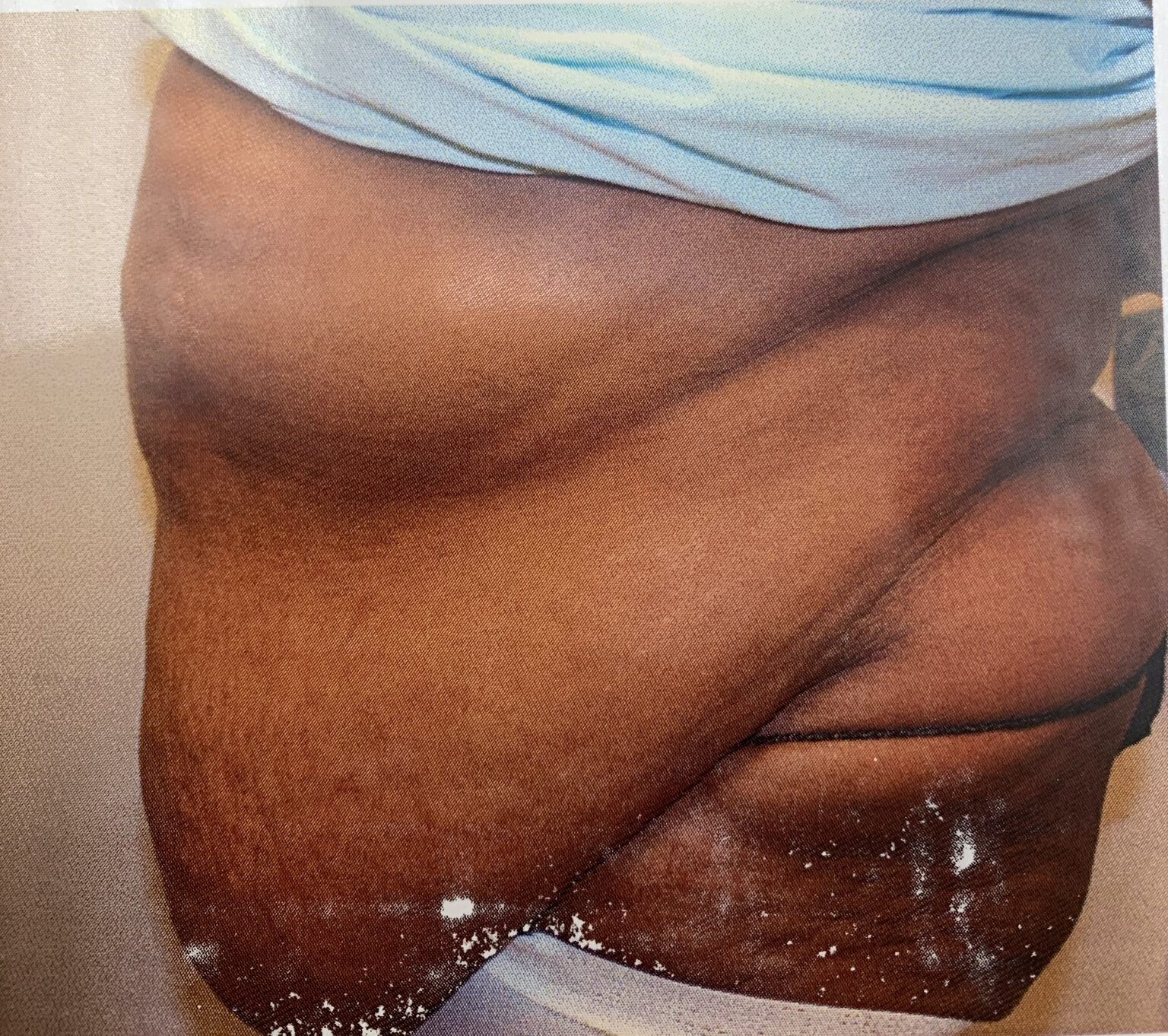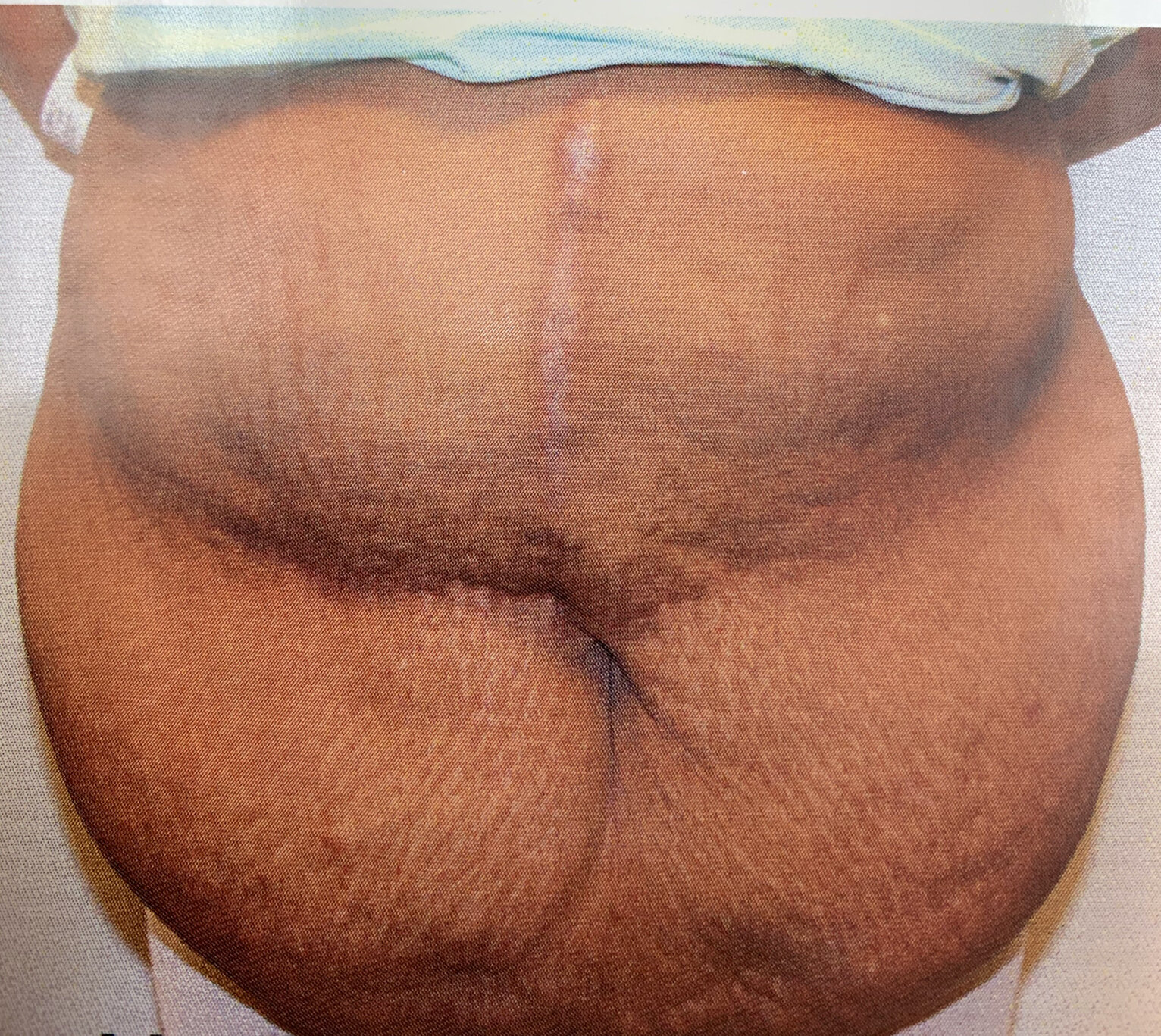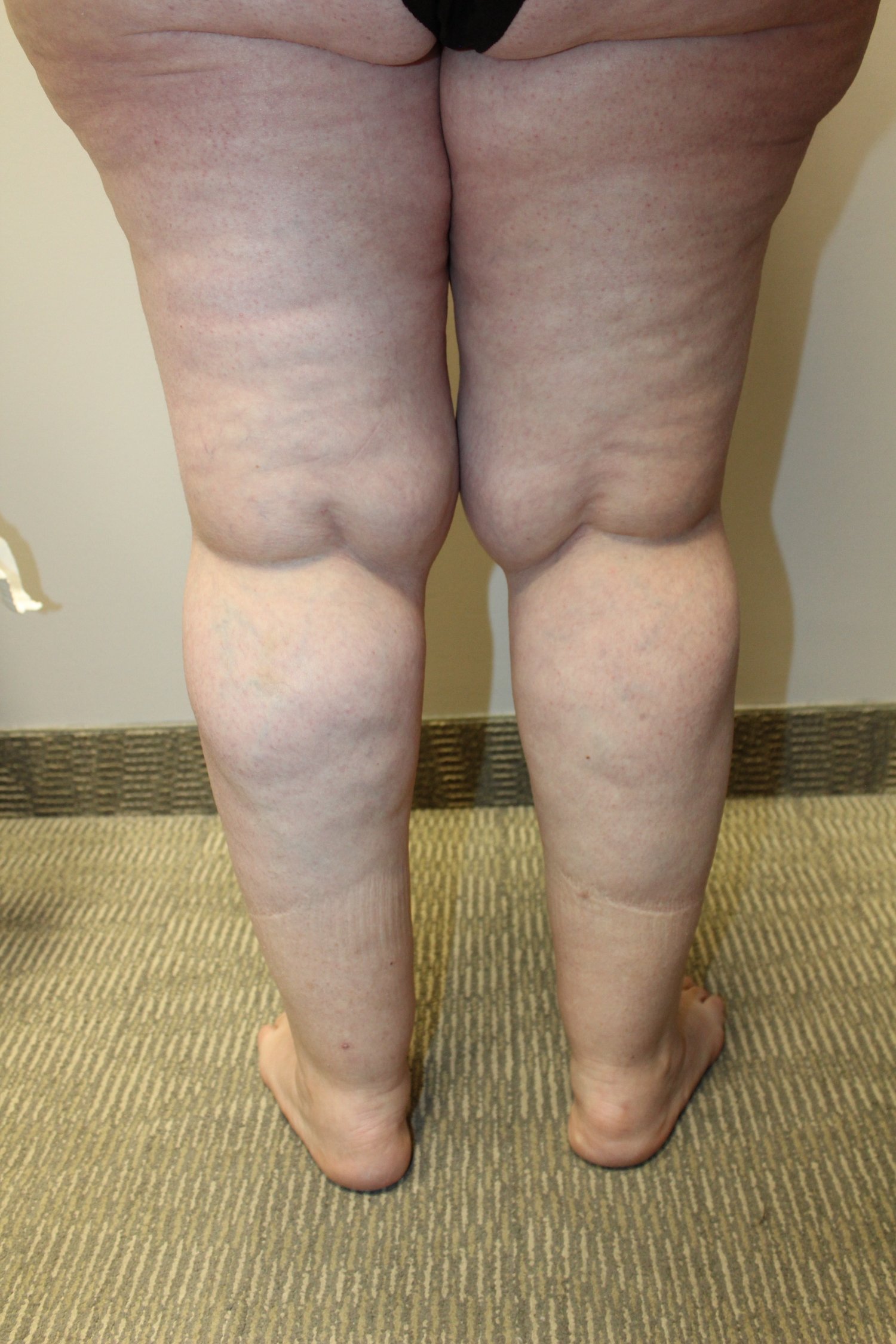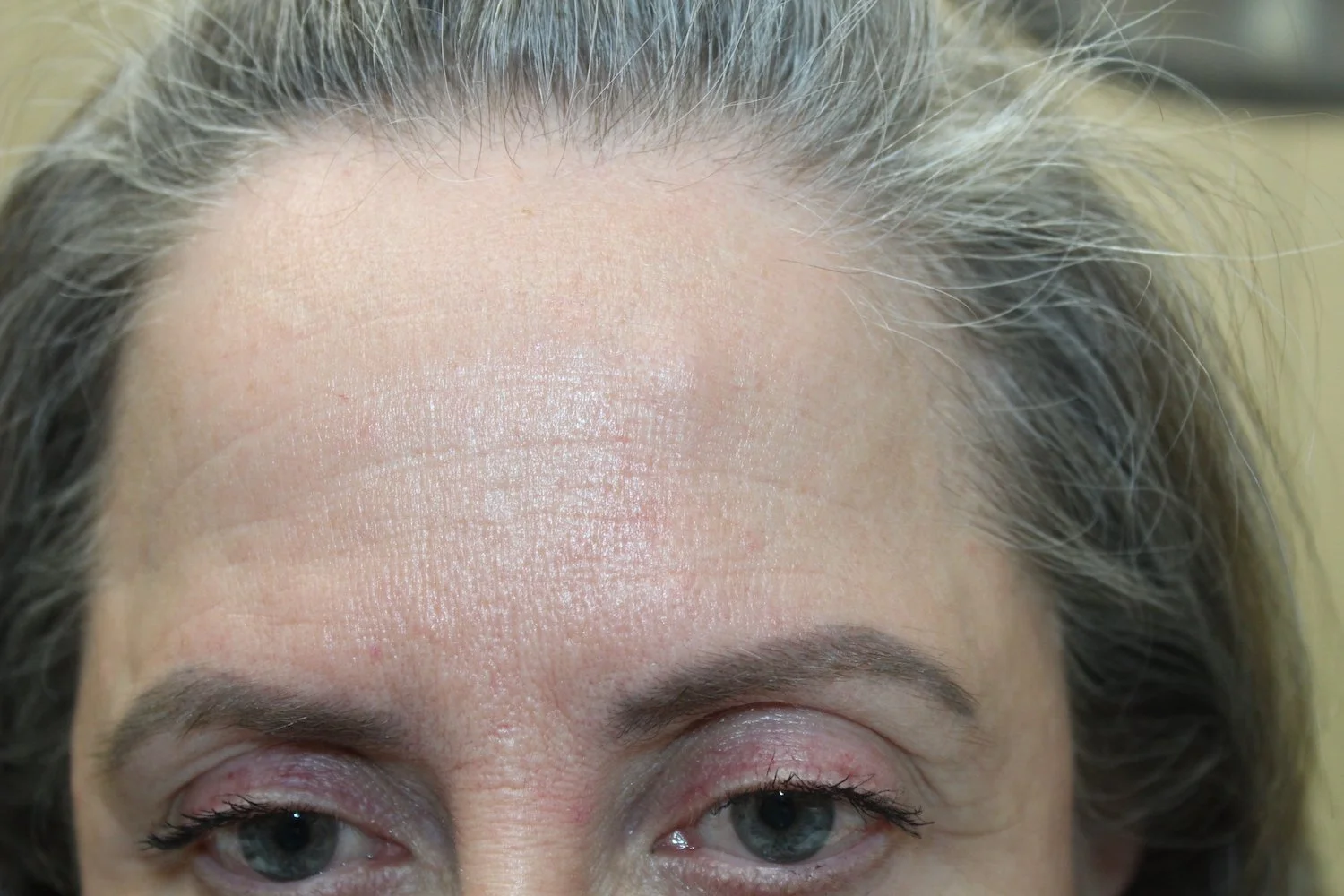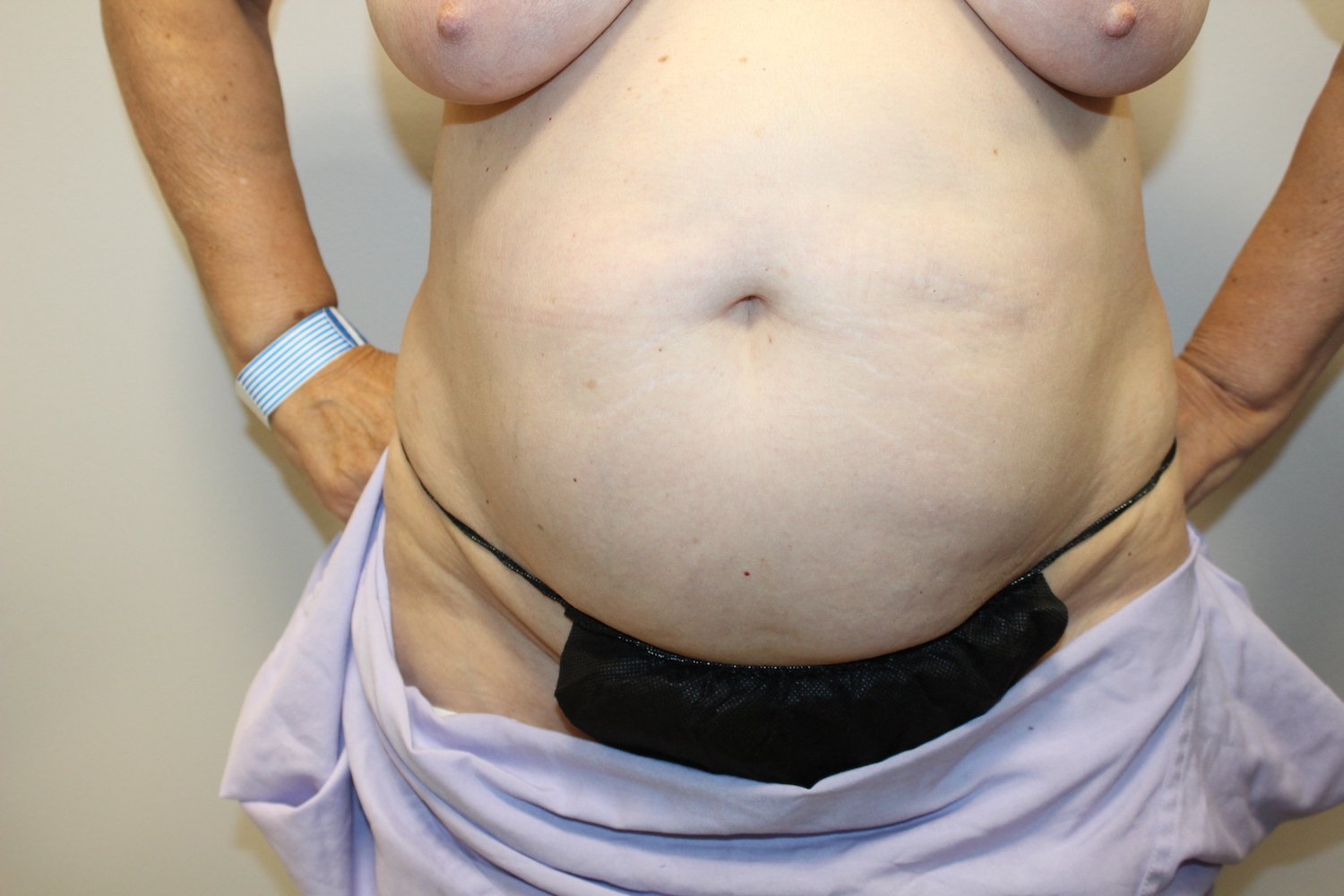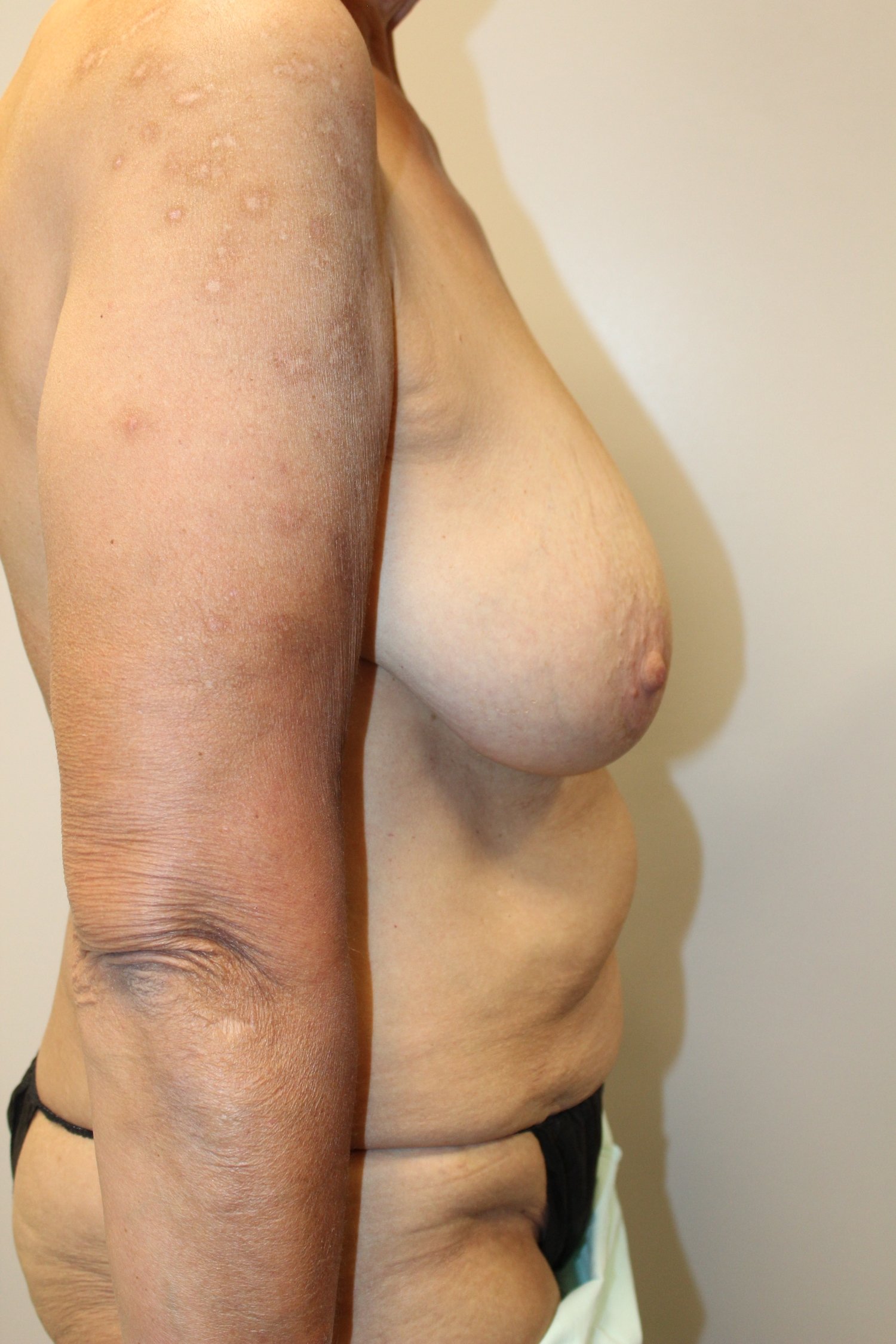
Tummy Tuck
*DISCLAIMER: THIS SITE CONTAINS GRAPHIC & SURGICAL IMAGES THAT MAY BE DISTURBING TO SOME VIEWERS.
THIS SITE IS INTENDED FOR INDIVIDUALS OVER THE AGE OF 18.
**None of the images on this site have been enhanced or photoshopped.
Patient C - Tummy Tuck (BMI 18.5 - 24)

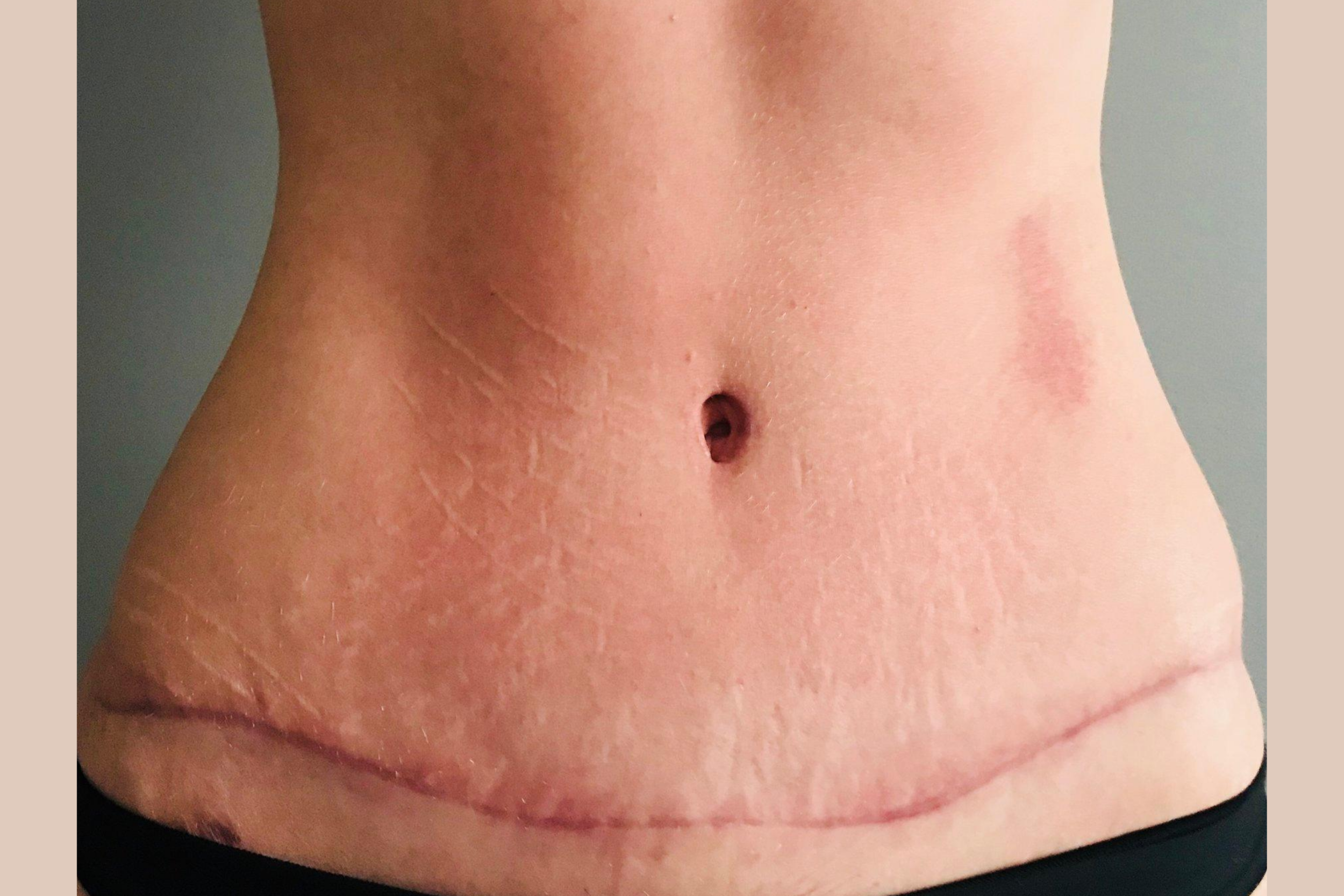
Patient E - Tummy Tuck (BMI 18.5 - 24)


Patient F - Tummy Tuck (BMI 25 - 29)


Patient Q - Tummy Tuck (BMI 30 - 34)


Patient R - Tummy Tuck (BMI 35 - 39)


Patient S - Tummy Tuck (BMI 40+)


Calculate your BMI:
Before & After Photos
*Tap a patient image to enlarge & view the full series of pre and post-operative images.*Tap a patient image to enlarge & view the full series of pre and post-operative images.
Before the Surgery:
+ What is a Tummy Tuck?
This is a surgical operation to improve the appearance and contour of the upper and lower abdomen by lifting the mons pubis area (hair line area), removing fat and skin from the lower abdomen, removing fat from the upper abdomen, and the mons pubis area, tightening the abdominal muscles, and then tightening the abdominal skin.
A tummy tuck treats skin, fat, and muscle.
It is also referred to as an abdominoplasty.
+ Who can have this operation?
The typical patient who is a candidate for a tummy tuck procedure has excess skin, or, skin and fat over the abdomen that has not responded to weight loss and/or exercise.
This applies to both men and women.
+ Why does skin and fat not respond to weight loss and/or exercise?
In women, after pregnancy, the skin and muscles of the abdomen have been significantly stretched. The skin and muscle may not return to normal after the pregnancy and breast feeding.
If this happens, there will be excess abdominal skin leaving a skin ripple or extra skin folds over the upper and lower portion of the abdomen.
This excess skin may be accompanied by residual fat that did not disappear from the pregnancy, or may be the result of weight gain after pregnancy in women, or generalized weight gain in both women and men.
The muscle stretch following pregnancy may produce a bulging tummy and a rectus muscle diastasis (a separation of the abdominal muscles).
In men, a significant weight loss or weight gain can produce the same abdominal deformity as seen in women.
Patients who have gained a significant amount of weight can have a significant bulge of skin and fat over the belt line. This is called an abdominal pannus.
+ When can a Tummy Tuck be done?
The timing for a tummy tuck procedure is most often planned after the patient has completed her family.
The patient’s weight should be stable.
+ Do I have to lose weight before a Tummy Tuck?
If the patient feels they are overweight and wants to lose a certain amount of weight before proceeding to a tummy tuck, this is fine, provided that the patient can maintain this new life style by permanently keeping this lost weight off.
What is critical is not to lose weight through an aggressive diet and exercise regime before tummy tuck surgery that is not sustainable. For example if the patient loses 20lbs using an aggressive weight loss program before the tummy tuck surgery, but can’t maintain this life style after surgery, and the 20 lbs is slowly regained. At one year, with the regain of the previously lost 20lbs, the surgical result will be inferior.
Dr. Giuffre advises that the patient comes into tummy tuck surgery at a weight that is a “no brainer weight”: a weight that is stable, that the patient has maintained for months or years, based on their current life style. There will be no extra ordinary effort for the patient to maintain this weight after surgery. The surgical result will then be maintained without changing the patient’s life style.
+ What if I lose weight after surgery?
This is not unusual. The tummy tuck surgery often assists the patient in their regular and exercise activities, resulting in a higher daily calorie burn.
A weight loss after tummy tuck surgery will not affect the result of the tummy tuck surgery, but will reduce other areas of body fat over the hips, arms, buttocks etc.
Postoperatively, a change in life style to permanently lose weight will not affect the result of the tummy tuck surgery.
+ Am I a candidate for a “mini tummy tuck”?
A mini tummy tuck is a procedure designed to correct a small lower abdominal bulge between the belly button (umbilicus) and the hair line (mons pubis area).
It involves removal of fat using a liposuction technique, combined with a limited removal of skin without muscle tightening. It does nothing to improve the area of the abdomen above the umbilicus.
It is most often limited to patients who have never been pregnant.
In the consultation with Dr. Giuffre, a full tummy tuck, versus, a mini tummy tuck, options will be discussed.
+ My problem is not so much skin and fat hanging over the belt line (abdominal pannus), but a big bulging upper abdomen. What do I do for this?
Over weight patients distribute excess fat differently.
The typical fat distribution in women and in some men is peripheral. This means the excess fat occur in the layers between the skin and the abdominal muscles, which produces the pannus.
This can be treated surgically with the tummy tuck procedure.
The typical fat distribution in a man, and occasionally in some women, is visceral. This means the excess fat collects within the abdomen around the intestines, and the organs, like the liver, spleen, and pancreas. This produces a large, often firm bulge, in the upper and lower abdomen, like a barrel.
This cannot be treated surgically. To lose this excess weight will require a non-surgical weight loss regime.
After successful weight loss, an abdominal pannus may result which can then be treated surgically with a tummy tuck procedure.
+ I have heard of the “Mommy make over”. What is it?
A mommy make over refers to restoration surgery to the breast (breast lift, breast reduction, or breast augmentation or any combination of these), combined with a tummy tuck procedure.
+ Is tummy tuck surgery covered by AHS (Alberta Health Care) if I get a referral from by GP?
The tummy tuck procedure is considered a cosmetic procedure by AHS and is therefore not covered even with a referral from the Family Physician.
+ What if I have a Caesarian Section scar, or a Hysterectomy scar, that is unattractive and causes a deformity and discomfort?
The C-section scar or hysterectomy scar is removed with the tummy tuck surgery, along with the underlying scar and deformity the scar produces.
AHS will not cover this part of the Tummy Tuck procedure.
+ I am a massive weight loss patient. Can I have a Tummy tuck and is it covered by AHS (Alberta Health Care)?
If the resulting Abdominal Pannus is massive causing chronic infection, hygiene difficulties and impedance of the ability to ambulate because the pannus rests on the upper thighs, AHS will cover a procedure called a Panniculectomy.
+ How does a Panniculectomy differ from a Tummy Tuck or Abdominoplasty?
A Panniculectomy is an amputation of the large pannus to remove the excess fat and skin. Often the umbilicus is sacrificed. It is a functional operation designed to assist in ambulation and hygiene ease. It is not a cosmetic procedure designed to improve the shape, contour and appearance of the abdomen.
If the abdominal pannus is significant but not massive, a cosmetic tummy tuck can often be done which will improve the shape, contour and appearance of the abdomen. This would not be covered by AHS because it is considered cosmetic, not functional.
Patients that have lost a considerable amount of weight may also have cosmetic issues with excess skin and fat involving the upper arms, upper thighs, back, hips and buttocks, and breasts. Please refer to respective sections under the FAQ for each of these areas.
The Operation:
+ Do I have to go to sleep (General Anesthesia) to have a Tummy Tuck?
A General Anaesthetic is required in all cases.
+ How long does the operation last?
Approximately one and one half hours to 2 hours.
+ Where is the surgery done?
Dr Giuffre uses a private surgical suite adjacent to his Meadowlark Health Centre Office(#176) for his cosmetic procedures.
Please See: https://www.meadowlarksurgicalcosmetic.com
+ Where is the incision made for an Abdominoplasty?
The most common incision is placed in the natural crease formed where the excess skin of the pannus meets the abdominal wall in the hip area. The incision follows this natural crease, just above the hair line to the opposite hip.
There is also an incision around the patient’s umbilicus (belly button).
+ Will there be a scar?
Yes. Any incision in the skin, regardless of where in the body will heal with a scar. The scar will mature (the scar color goes from red to pink to white and the scar softens and becomes pliable) which can take 1-2 years. Medical paper tape placed directly over the incision and changed weekly for 3 months, will help speed up the process of scar maturation.
+ Will I have stitches?
Yes, the stitches are under the skin and absorb (disappear by themselves) so no sutures are removed.
+ What happens surgically in a Tummy Tuck?
- Before the surgery, with the patient standing, the surgical plan is made by drawing on the abdomen. The amount of skin and fat excision is planned.
- A photograph is taken. The patient will receive a copy of the preoperative photograph at the 6 week check with Dr. Giuffre
- Once the patient is asleep, (General Anaesthetic) the incisions are made.
- The excess skin and fat is removed, the muscles are repaired above and below the umbilicus (belly button), the patient’s umbilicus is relocated in the new abdominal skin and the incisions are then closed with self-dissolving stitching under the skin.
- There is always a drainage tube that is placed in the surgery site. This will remain for between 1-2 weeks. When the drainage slows or stops, Dr. Giuffre will remove this drain which is minimally uncomfortable.
+ What happens after my surgery?
- You will have a firm felt binder-like dressing on for the first day after surgery. You will go home with this.
- You will be seen the next day, after surgery, where all of the dressings will be removed.
- You may then shower. No further dressings are required.
- You are discouraged from having a bath, hot tub, or swimming for 6 weeks following surgery.
- You are encouraged to walk the day of surgery to avoid the risk of blood clots in your legs, (during the surgery you will have had special sequential stockings on your legs that maintain normal leg circulation).
- The drainage tube will be removed when the drainage is 25 cc’s in 24 hours for a day or two.
- Once the drainage tube is out, you are encouraged to wear a Spanx garment or abdominal binder to support the surgery site for 6 weeks.
- Arrangements will be made to see Dr. Giuffre at 6 weeks postoperatively
+ Is the Tummy Tuck procedure painful?
Before waking from the surgery, Dr. Giuffre will inject a long acting local anesthetic into the abdominal area to decrease any immediate abdominal discomfort from the surgery.
When the freezing wears off, the patient will require postoperative analgesic medication (pain killers) for up to a week. The discomfort typically subsides after the first two to three days following the surgery.
Patients taking prescription pain killers should not drive a car, operate machinery, or sign significant documents while taking this medication.
+ Do I go home the same day as Surgery?
Yes. You will have to arrange a ride and aftercare with a responsible adult.
You are not permitted to leave unaccompanied or in a taxi.
+ I live out of town. Should I stay overnight?
If your driving distance from Edmonton exceeds 90 minutes, you should make arrangements to stay overnight in Edmonton. The surgical centre does not have an overnight care facility. You will then be seen the following day for dressing removal and assessment by Dr. Giuffre and his staff.
+ Can I contact my surgeon the day or night of surgery if I have a concern?
Yes. Dr. Giuffre provides his home phone number to his cosmetic patients in case there are patient concerns.
In the rare instance that a patient requires hospitalization, Dr. Giuffre has admitting privileges to all the major hospitals in Edmonton.
+ When do I see my surgeon after surgery?
You will be seen the day following surgery by Dr. Giuffre, and/or his nursing staff, and again within the week following your surgery by Dr. Giuffre.
Further follow up arrangements will be made at that time.
+ When can I shower?
A shower is okay after the first dressing change, which is usually done the next day after surgery. It is okay to get the incision wet from a shower, but Dr. Giuffre recommends that you avoid a hot tub or bath, swimming pools, lakes, or ocean swimming for 6 weeks following surgery.
+ In what position can I sleep?
In whatever position is comfortable for you.
+ When can I resume relations with my partner?
6 weeks is recommended.
+ What should I do to minimize scarring?
Vitamin E oil and Bio oil are not proven to positively impact scar healing.
Dr. Giuffre recommends medical paper placed on the incision for 3 months, changed weekly by the patient.
+ How long should I plan to be off work?
The typical time off work is two weeks. If your work is extremely strenuous, and involves heavy lifting, the time off work will be longer.
+ How long am I off sports and my workouts?
No sports or strenuous activity is recommended for 6 weeks. Patients are to avoid strenuous activity that increases their heart rate and blood pressure. This could produce bleeding inside the surgical site. The rule of thumb is, if you are sweating from the activity, you are over doing it and you are placing yourself at risk.
+ What about eating and drinking after my tummy tuck?
Regular food consumption and drinking as the patient did preoperatively is recommended
+ Are there before and after pictures?
Yes. Every patient that Dr. Giuffre operates on for cosmetic reasons, will have a preoperative photograph taken. At the 6 week check up with Dr. Giuffre, his patients are given an 8 x 10 preoperative photograph.
Postoperative photos are also taken in some instances.
The Risks:
+ What are the risks of doing a Tummy Tuck procedure?
With any surgery there are surgical and anesthetic risks.
Aside from the rare risks of an anesthetic event, some of the general and specific surgical risks for this procedure would include:
- Scarring
- Infection
- Sensation change to the lower abdomen above the hairline at the mons pubis
- Discomfort
- Time off work and exercise
- Bleeding (hematoma)
- Seroma (fluid collection after the drain is removed)
- Excess scarring around the umbilicus
- Tissue loss above the mons pubis area in patients with previous abdominal surgery or in smokers
- Asymmetry
- Deep vein thrombosis (blood clots in the legs)
*This list is not complete.
During the consultation with the patient, Dr. Giuffre will outline and explain each of the risks in detail.
The Followup:
+ How often do I need to come back for a checkup after surgery?
Postoperative visits include a 24 hour visit, a 1 week visit, and a 6 week visit. If there are any patient concerns, Dr. Giuffre provides his home phone number for patient's direct access. After the 6 week visit, if there are any future requests for an appointment, they are made directly with Dr. Giuffre's office and an expedited visit is arranged.
+ I no longer have access to my original surgeon. What can I do?
For cosmetic or reconstructive concerns, patients are invited to contact Dr. Giuffre's office (780-428-7737) for an appointment. He does not require a referral and there is no charge for the consultation.
+ I had a Tummy Tuck with another surgeon and I am unhappy. What can I do?
It is always wise to re-consult with your original surgeon in order that he can assess you and your concerns. If that fails or you are still unhappy with your options, you can always seek a second opinion. Dr. Giuffre would communicate your concerns with your original surgeon in order to facilitate a resolution.
+ I had a Tummy Tuck in another country. I have a problem. What can I do?
For cosmetic or reconstructive concerns, patients are invited to contact Dr. Giuffre's office (780-428-7737) for an appointment. He does not require a referral and there is no charge for the consultation.
+ I had a Tummy Tuck years ago. I have gained weight and I am unhappy with my result. What can I do?
This can happen from weight change, pregnancy, aging, and menopause. A consultation with a Dr. Giuffre is recommended to review the cause and options for improvement.
Financing:
+ Is tummy tuck surgery covered by AHS (Alberta Health Care) if I get a referral from by GP?
The tummy tuck procedure is considered a cosmetic procedure by AHS, and is therefore not covered, even with a referral from the Family Physician.
+ What if I have had a Caesarian Section scar or a Hysterectomy scar that is unattractive and causes a deformity and discomfort?
The C-section scar or hysterectomy scar is removed with the tummy tuck surgery, along with the underlying scar and deformity the scar produces.
AHS will not cover this part of the Tummy Tuck procedure.
+ I am a massive weight loss patient. Can I have a Tummy tuck and is it covered by AHS (Alberta Health Care)?
If the resulting Abdominal Pannus is massive causing chronic infection, hygiene difficulties and impedance of the ability to ambulate because the pannus rests on the upper thighs, AHS will cover a procedure called a Panniculectomy.
+ Can I use the costs of a Tummy Tuck as a tax deduction?
CRA eliminated the use of cosmetic surgery as a tax deduction a number of years ago. Unless you can demonstrate the procedure is a promotional cost for your business, it is not tax deductible.
If there is a medical need confirmed by your doctor, you may be able to deduct the cost with a letter from your doctor outlining the medical need/necessity for the procedure along with the receipt for the surgery.
+ Can I finance the costs of the surgery? How do I do this?
Dr. Giuffre does not provide in house financing for cosmetic procedures.
There are a number of companies across Canada that will finance cosmetic surgery similar to car financing or mortgages. Please refer to the links provided for this information.
Examples are:
Dr. Giuffre has no financial or business relationship or affiliation with any of these companies.
+ If something goes wrong, do I have to repay for the operation?
You do not have to pay for the treatment of an immediate complication. In the unusual event that there is a problem with your original surgery you do not have to pay for the correction.
+ How much does it cost?
The cost of cosmetic surgery is covered entirely by the patient. The one fee would include:
- The cost of the anesthetist (who provides the General Anesthetic)
- The rental of the operating room and equipment
- The rental of the recovery room and equipment
- The staff, including the nurses and administration staff
- The surgical fee.
The cost will vary depending on the duration of the procedure and the quality and sophistication of the surgical facility where the surgery is performed.
The fees will be discussed at the time of consultation with Dr. Giuffre.
There is no obligation to proceed with surgery following the consultation. The patient is referred to our web sites and is invited back for a second consultation if need be.
Please visit https://www.meadowlarksurgicalcosmetic.com
Our office will endeavour to expedite a surgical procedure to accommodate both business and family obligations.
All fees are receipted. GST payment is required.
+ What about having my Cosmetic Surgery in another country where it is cheaper?
There is a current trend to have surgery out of your country where the surgery may be cheaper.
We call this tourist surgery.
There are a number of additional risks associated with tourist surgery, which include:
The surgical skill, experience, licensing and education of an unknown surgeon.
Canada has very strict rules and requirements to be a licensed Plastic Surgeon (FRCS(C)) in our country. Your Plastic Surgeon has completed an undergraduate degree (4 years), an MD degree (4 years), a Fellowship Degree in Plastic Surgery (5 years) and often a post Fellowship (1-2 years).
A “friend” is not a good reference, nor is glitzy advertising.
The safety, sterility and equipment quality, including anaesthesia machines in the hospital or private surgical suite could be questionable; this may lead to increased risk of infection and anaesthetic risks.
Post operative care is limited to the time you spend in their country.
If you have a complication, to see your original surgeon, you will have to fly back to where your procedure took place, or see a new surgeon in your own Country.
If you have an unsatisfactory result, you will have to fly back to see your original surgeon or find a new Surgeon.
The cost of the repair may exceed what you originally paid, and the final result, fixing a mistake, is often not as good as it could have been had the surgery been done correctly the first time.
After accounting for the accumulated costs of the air travel, hotel, surgery and postoperative care, the perceived cost savings may not be significant.
If you have a severe, life threatening complication, Alberta Health Care will cover the medical costs for your care.
Correcting the reconstructive problem, as a result of the complication, would be the patient’s financial responsibility.
“Life is full of choices; your character reflects those choices.”













